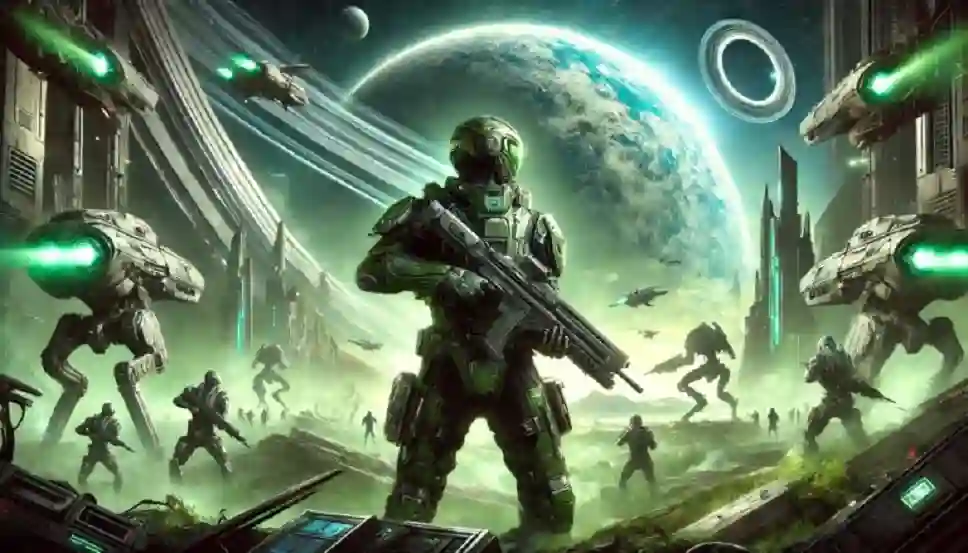
The Music of Halo (2003): How the Soundtrack Became Legendary
When Halo: Combat Evolved was released in 2001 by Bungie Studios, it revolutionized first-person shooters and became a cultural phenomenon. However, one aspect that left an indelible mark on players was its iconic soundtrack. Composed by Martin O’Donnell and Michael Salvatori, the music of Halo: Combat Evolved (released in 2003 for Windows) became legendary, influencing not only video game soundtracks but also pop culture at large.
The Impact of the Halo Soundtrack
A Defining Sound for a New Era in Gaming
Video game soundtracks in the early 2000s were evolving rapidly. Moving away from simple, MIDI-based compositions, developers began utilizing orchestral and cinematic elements to create immersive experiences. Halo: Combat Evolved was among the first games to fully embrace this approach. O’Donnell and Salvatori’s work elevated the gaming experience, providing players with an epic score that felt larger than life.
From the moment players booted up the game, they were greeted with the Gregorian chant of the main theme—a solemn and mystical tone that perfectly matched the grandeur of the game’s universe. The blend of choral arrangements, strings, and percussion was unlike anything heard in video games before, and it set the stage for a soundtrack that would be celebrated for years.
Balancing Atmosphere and Action
One of the key reasons the Halo soundtrack resonated with so many players was its ability to balance atmosphere and action seamlessly. Each track was composed to match the pacing and tone of the game’s levels, whether players were exploring a vast alien world or engaging in intense firefights.
For instance, “A Walk in the Woods” captures the mystery and serenity of Halo’s landscapes with soft strings and woodwinds, while “Rock Anthem for Saving the World” drives players through high-stakes combat sequences with intense percussion and electric guitar riffs. This dynamic approach to music not only heightened the emotional experience but also helped players feel more connected to the game world.
Martin O’Donnell and Michael Salvatori: The Composers Behind the Magic
The Collaborative Process
Martin O’Donnell and Michael Salvatori, the masterminds behind the Halo score, had worked together on several projects before taking on Halo: Combat Evolved. Their chemistry and complementary styles were crucial to the soundtrack’s success.
O’Donnell, who had a background in television and radio commercials, brought cinematic instincts and a knack for creating memorable themes. Salvatori, on the other hand, added depth to the compositions with his expertise in orchestration. Together, they created a soundtrack that merged the classical with the modern, a sound that felt at home in a futuristic sci-fi universe while still tapping into something primal and timeless.
A Signature Sound
The signature sound of Halo can be attributed to the composers’ decision to use a mix of traditional orchestral instruments, electronic elements, and vocal harmonies. The Gregorian chants, which became synonymous with the franchise, were an inspired choice. According to O’Donnell, the chants were meant to evoke a sense of ancient mystery, fitting the game’s themes of ancient alien civilizations and the epic struggle between humanity and the Covenant.
Tracks like “Perilous Journey” feature rhythmic drums and tense strings, which build anticipation and create a sense of urgency, while “The Maw” combines dissonant electronic sounds with orchestral arrangements, giving players a feeling of both wonder and danger. These compositions work not just as background music but as a critical part of the game’s storytelling.
The Soundtrack’s Lasting Legacy
Influence on Video Game Music
The Halo soundtrack set a new standard for video game music. Its success proved that video game scores could be just as powerful and emotionally engaging as those of blockbuster films. Many games that followed, such as Mass Effect and Gears of War, adopted a similar approach, utilizing cinematic scores to enhance their narratives.
The soundtrack also helped to elevate the status of video game music within the entertainment industry. The Halo score was released as a standalone album, and tracks from the game were performed by live orchestras in concerts around the world. This was a major achievement for video game music, which had long been overlooked by mainstream audiences.
Expanding Beyond the Game
The Halo soundtrack became so iconic that it transcended the game itself. The main theme, with its recognizable Gregorian chant, has been featured in advertisements, television shows, and even sports arenas. The soundtrack’s influence can be felt in various forms of media, from fan-made remixes to professional performances at gaming events and symphonies.
Additionally, the legacy of the Halo soundtrack carried forward into future games in the series. O’Donnell and Salvatori continued to collaborate on the music for subsequent Halo games, expanding upon the themes they had established in the original. Even today, fans of the series associate the distinctive sound of the Halo score with the excitement and emotion they felt playing the game.
Conclusion: A Masterpiece of Video Game Music
The soundtrack of Halo: Combat Evolved stands as one of the greatest achievements in video game music. Martin O’Donnell and Michael Salvatori’s compositions have become synonymous with the Halo series and the broader world of gaming. Their blend of orchestral, electronic, and vocal elements created an immersive and emotionally resonant experience that has inspired countless other video game composers.
With its iconic main theme, atmospheric soundscapes, and pulse-pounding action tracks, the Halo soundtrack not only enhanced the gameplay experience but also left a lasting impression on the cultural landscape. More than 20 years after its release, the music of Halo remains a timeless example of how a great soundtrack can elevate a video game to legendary status.
